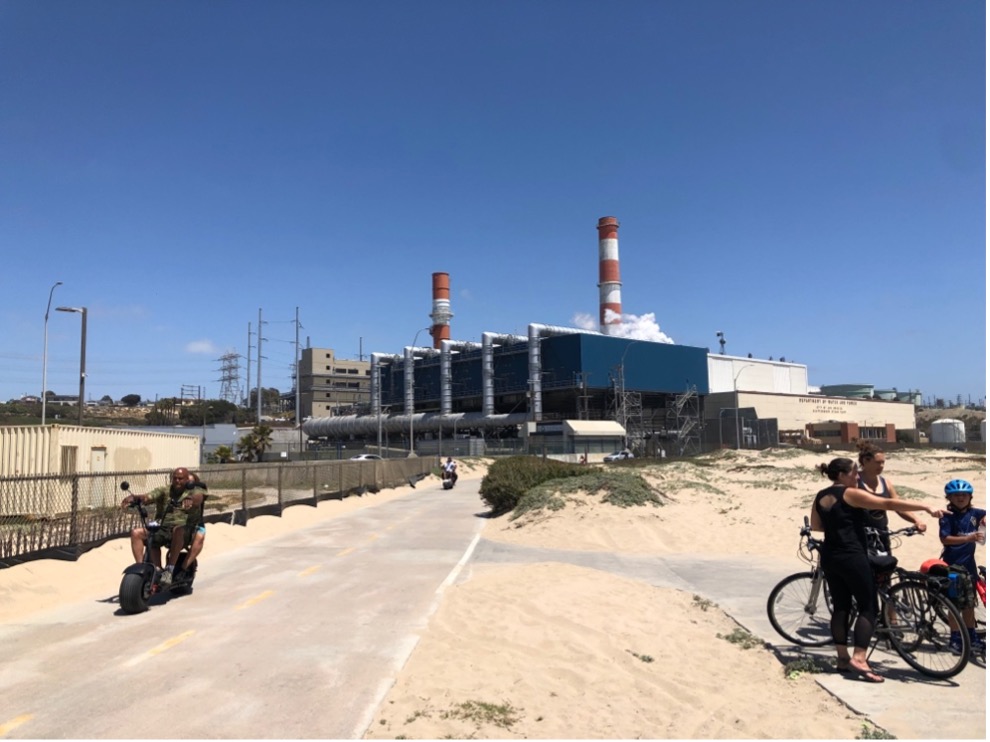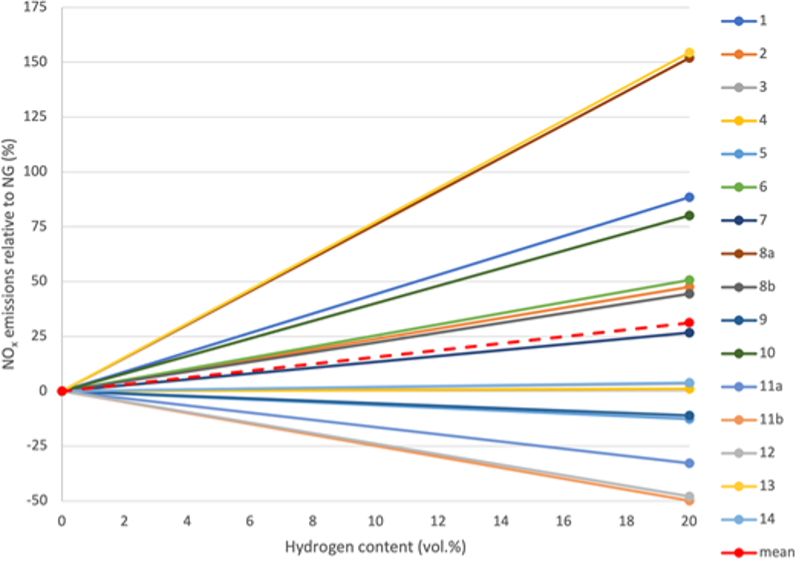Unraveling LA’s Hydrogen Combustion Experiment
Combusting hydrogen could keep natural gas plants online, but they won’t be “green” for years––if ever.
This is Part II of “Unraveling Hydrogen,” a series covering the basics of hydrogen policy. The first post, introducing the series and covering how hydrogen is produced, is available here.

Led Zeppelin’s eponymous 1969 album featured an iconic photo of the Airship Hindenburg going up in flames above Lakewood, New Jersey in 1937. By all accounts, it took between 32 and 37 seconds from the first signs of a fire for the dirigible to come plummeting to the ground. The fire and resulting crash killed 36 people.
While this disaster spelled the end of the airship era, it also sealed the image of hydrogen as a volatile and dangerous fuel in the public consciousness for decades. The public generally blamed the accident on the seven million cubic feet of hydrogen installed at the center of the ship. In subsequent years, hydrogen was mostly limited to use as feedstock for industrial applications, including the production of fertilizers, synthetic textiles, and drug precursors.
But with the recent influx of government incentives for hydrogen production, new and improving production and storage technologies, and greater political will than ever before, H2’s reputation is gaining favor. Hydrogen’s supply-side has been buttressed by incentives from state and federal governments, refineries and utilities looking to extend the life of fossil fuel infrastructure, and renewable energy companies seeking to take advantage of the huge amounts of clean energy needed to produce green hydrogen. But this still leaves questions about the demand-side market. What if––despite the hype and incentives around hydrogen production––it still struggles to beat incumbent technologies and practices like battery storage, demand-response, or electrification of buildings and vehicles? Or, perhaps more realistically, what if hydrogen policy evolves to artificially prop up the market for hydrogen, even where decision-makers could better serve the climate and the environment by promoting other strategies?
In the abstract, the use-cases for hydrogen are broad. Hydrogen can be used for medium-to-long-term energy storage, heat and power generation, and transportation. But for many of these use-cases, hydrogen doesn’t do the job particularly well, at least as compared to existing technology. This is partly because hydrogen production is energy inefficient and––when derived from fossil fuels––still a significant source of carbon emissions. Inefficient end uses for hydrogen can further exacerbate this problem. Critically, and as we’ll discuss in greater depth shortly, hydrogen combustion (as opposed to its use in fuel cells) also leads to greater emissions of nitrogen oxides (NOx), a toxic group of pollutants regulated under the Clean Air Act.
All this is not to say there is no place for hydrogen in a clean energy future. Green hydrogen––produced with renewable electricity and water––is often described as a tool for decarbonizing the challenging last 10% of greenhouse gas emissions. On the other hand, cramming hydrogen into roles that it is not suited for will do more harm than good for health and climate outcomes. Therefore, the next few entries in this series discuss the various potential uses for hydrogen and their utility in advancing climate goals, starting with the combustion of hydrogen in natural gas plants.

I originally wanted this entry to cover a broad sampling of the most frequently discussed use-cases for hydrogen. However, hydrogen combustion is simply too topical right now not to devote a whole post to it. Los Angeles City Council voted last month to move forward with an $800 million plan to blend hydrogen with natural gas (“hydrogen blending”) at the Scattergood Generating Station, which has received significant attention (including from our own Professor Zasloff) and notably been referred to as a “greenwashing boondoggle.” Much of the media coverage focused on how the goal is to ultimately (eventually, hopefully) burn 100% green hydrogen. What’s much more certain is that this gas plant will be burning a blend of methane and hydrogen for years.
The reasoning behind most hydrogen blending proposals is familiar. It generally follows the same logical sequence that gas companies invoke when defending the continued need for natural gas plants: Proponents argue that most renewable energy is intermittent, and batteries––while useful in smoothing variation in solar and wind power over daily cycles––cannot yet cost-effectively store power during multi-day storms or other contingency events that would inhibit renewable generation. This means that, as we transition to carbon-free energy, we still need firm power, and geothermal, nuclear, and hydroelectric are either difficult to scale, expensive, or politically inexpedient. Natural gas plants retrofitted to blend hydrogen, supporters insist, can cheaply and reliably fill this need with infrastructure that already exists.
By combusting hydrogen, these natural gas plants would stay online, but they would have a somewhat smaller carbon footprint, and could provide firm energy to meet demand. Proponents of these projects argue that, if natural gas plants are sticking around anyway, reducing their carbon emissions through blending is a low-hanging fruit. LADWP has even expressed a long-term––albeit aspirational––interest in further retrofitting these plants to burn only hydrogen by 2035. As straightforward as this sounds, however, hydrogen blending is not the solution that supporters make it out to be.
As promised previously, let’s begin by talking about NOx. NOx can form when naturally-occurring nitrogen in the air splits and oxidizes under high temperatures. This process does not require any specific fuel; it just needs a hot-enough combustion reaction. The hotter the reaction, the more NOx is created. This creates a problem for hydrogen blending, as hydrogen burns

about 500º F hotter than natural gas. One group of researchers found that burning pure hydrogen may produce six times as much NOx as burning natural gas.
NOx is a dangerous criteria pollutant. It’s linked to premature death, cardiopulmonary effects, decreased lung function in children, respiratory symptoms, and emergency room visits for asthma. It is also a precursor to other pollutants, including ozone (a key component of smog).
All this makes NOx a premier example of environmental injustice here in California. It’s emitted by refineries, ports, freeways, and industrial operators, which exist largely in communities of color and low-income communities. Unsurprisingly, natural gas plants are also disproportionately located in environmental justice communities; “half of California’s natural gas power plants are located in communities that rank among the 25% most disadvantaged.” Thus, proposals to retrofit existing natural gas plants with technology that would produce more NOx have received widespread criticism from environmental justice advocates. Building on these concerns, outgoing Councilmember Mike Bonin issued an open letter stating that increasing NOx emissions near environmental justice communities is “is not an acceptable tradeoff to achieve carbon reductions.”
But NOx is not the only issue with hydrogen blending. For starters, it is expensive to retrofit natural gas plants with the technology to combust hydrogen. As noted above, LADWP estimates that it will cost $800 million to outfit Scattergood with the technology to burn a 30% hydrogen blend (although some, including former city council members, believe this price will ultimately balloon to over $1 billion). While many proponents of hydrogen blending argue that these plants will one day burn 100% green hydrogen, there are currently no commercially available power plant turbines that can burn pure hydrogen. While small-scale demonstration projects burning pure hydrogen are set to become operational soon, the cost of retrofitting a large gas plant like Scattergood with this technology is unclear. Moreover, transporting anywhere close to that amount of green hydrogen would require even more significant––and even more expensive––investments in the distribution system.
It’s also important to note that––upstream impacts aside––combusting a 30% hydrogen blend does not translate to a 30% drop in carbon emissions. Hydrogen is far less energy-dense than natural gas, meaning that the proportion of hydrogen burned by volume is not equivalent to its share of energy generated. Because of this, a 30% hydrogen mix by volume delivers only a 10% reduction in carbon dioxide emissions. Moreover, as we will discuss in greater detail in later entries, hydrogen leaks may offset any climate benefit promised by hydrogen blending. Hydrogen is an indirect greenhouse gas that is up to 100 times more potent than carbon dioxide over a ten-year period.
All of the above creates a pretty dismal outlook for hydrogen blending in natural gas plants, but it doesn’t necessarily address the main talking point that supporters put forward: we still need firm energy, and hydrogen can reduce some of those carbon emissions.
Of course, this argument ignores the opportunity cost of building out the renewable generation needed to supply the green hydrogen underpinning these blending proposals. Proposals like LADWP’s Scattergood plan are silent on how they will source their green hydrogen (although LADWP likely envisions that it will come from SoCalGas’ nascent Angeles Link proposal). However, it’s clear that these producers will need dedicated supplies of renewable energy. Some of this will come from contracts for renewables that would otherwise be curtailed, but outside of relatively rare contingency events, that same energy could be paired more efficiently with battery storage or exported directly to the grid.
Ultimately, hydrogen blending proposals promise little in the way of climate benefits, but come with a high price tag, uncertainty in both feasibility and benefits, and jeopardize the health of local communities. And that’s to say nothing of the moral hazard of making huge investments into fossil fuel infrastructure, which may ultimately be passed along to ratepayers and could justify keeping that infrastructure online for many years.
In the next installment: A continued dive into hydrogen’s use as a transportation fuel.
Reader Comments
5 Replies to “Unraveling LA’s Hydrogen Combustion Experiment”
Comments are closed.






Very good summary, thanks.
Agreed. Very useful.
One question: what’s the max % of hydrogen in a natural gas mix that can be used without requiring power plant retrofit?
According to Jimmy Page, the band chose its name after Keith Moon said it would “go down like a lead balloon.” How did that go?
Hydrogen can be used in fuel cells to produce electricity without combustion, and without NOx emissions. It can also be used in turbines with improved flame control and heat recovery systems to produce both electricity and thermal energy while reducing NOx emissions. Additionally, cold energy from evaporators that are used to convert liquid hydrogen to hydrogen gas can be used to reduce turbine intake temperatures and increase efficiency, especially during summer months and in warmer climates.
While blending natural gas with hydrogen (up to 10% without significant retrofitting) has its disadvantages, continuing to use unblended natural gas (which is mostly methane) would have worse consequences.
The goal of completely replacing natural gas with hydrogen is worth pursuing, and while current systems are nascent, continued innovation and improvement in hydrogen technology suggest that we should “ramble on.”
Burning hydrogen mixture at lower temperatures would reduce NOx. Catalytic mufflers would completely eliminate NOx. If you save the O2 burn it directly with green hydrogen that would not produce any other pollution. One other is to produce electricity with fuel cells and run power components. Also combine the process of the NOx exhaust to produce fertilizers. Any way for the future you have no other energy choice so you have to make it work. Complaints of green people in this case is useless because they are attacking the only solution for energy for planet earth. Also it is an insult to show the Hindenburg in your article, which is a misapplication of hydrogen. Green people, hydrogen is the only fuel of the universe and is adaptable to the planets bio system. There is no other.
Those “relatively rare contingency events” are the entire reason for LA’s in-town combustion power plants after 2030, according to the LADWP’s draft Strategic Long Term Resource Plan, ladwp.com/sltrp, which says they’ll be needed something like 1% of the time.
People in LA are very touchy about power outages; the in-town plants are there as backup, to prevent outages when e.g. a transmission line goes down. Nearly all the rest of the time, wind and solar will be used directly or via batteries.
The 2022 SLTRP is well worth reading!